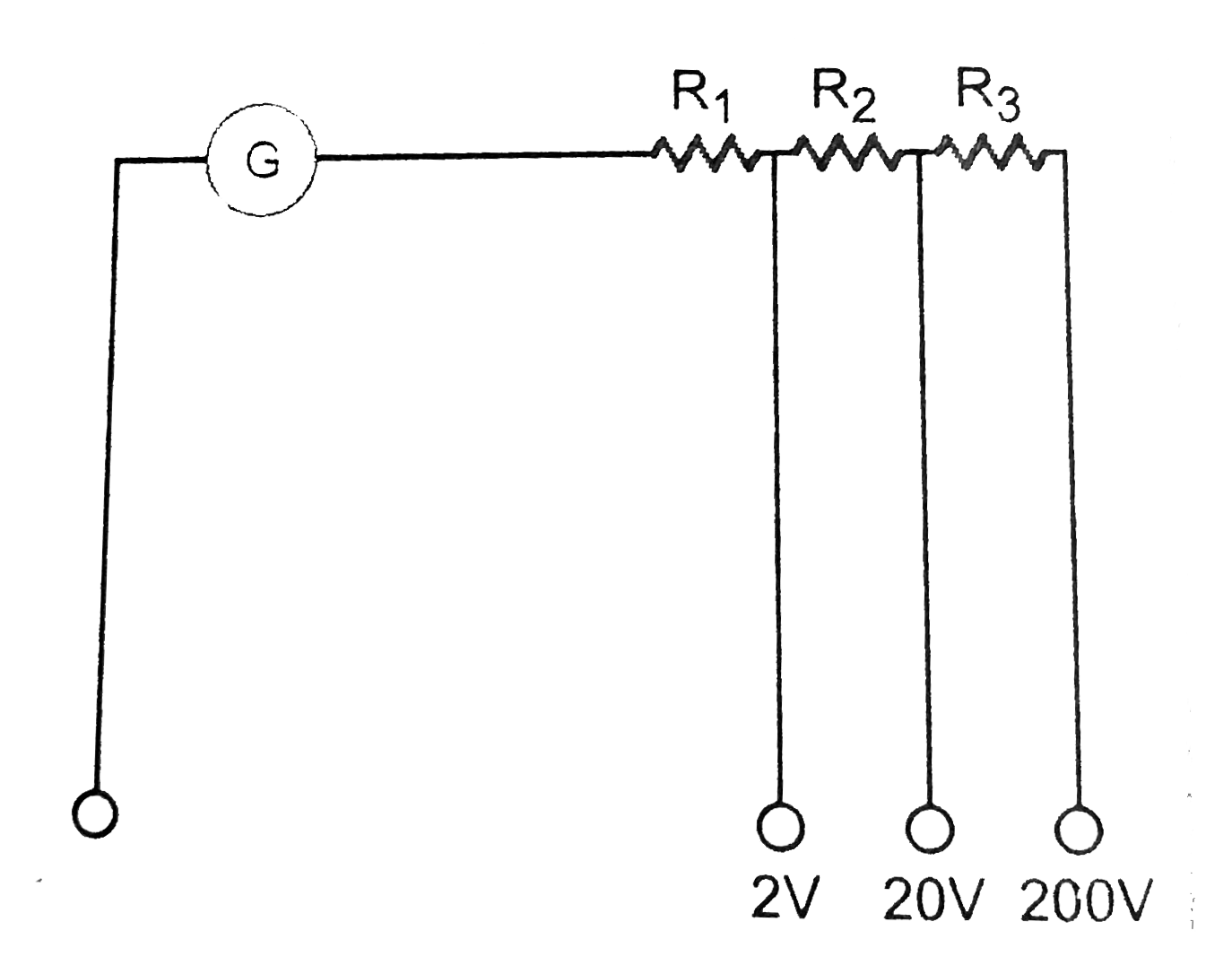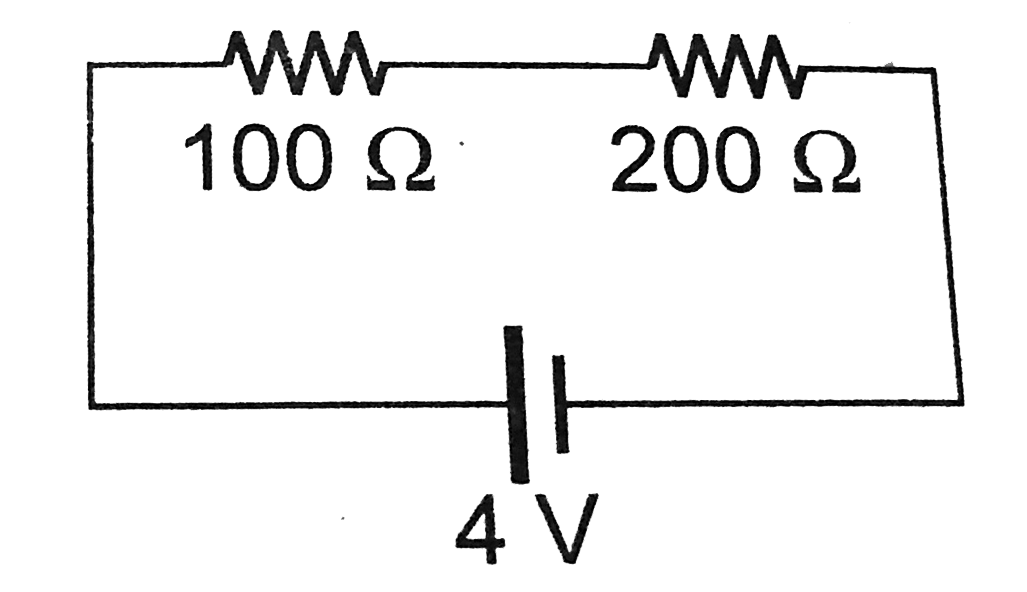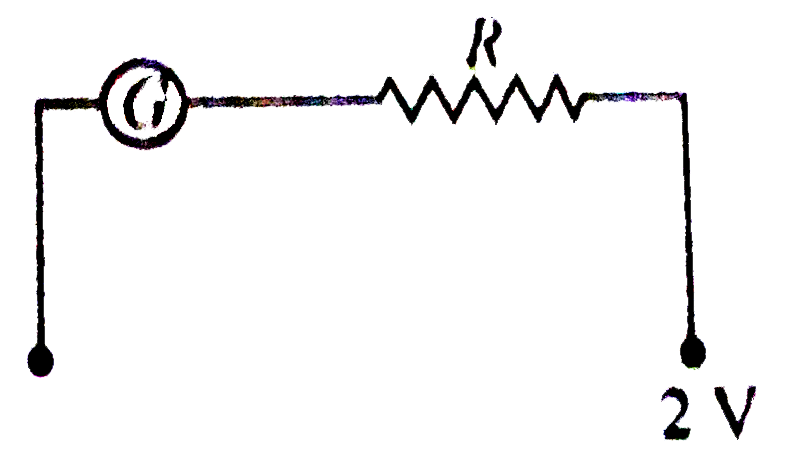Hwo can a voltmeter of resistance 200 ohm and measuring 10 V be used tomeasure a current of 5A ?
To solve the problem of how to use a voltmeter with a resistance of 200 ohms and a maximum reading of 10 V to measure a current of 5 A, we can follow these steps:
Step 1: Calculate the current through the voltmeter
The current through the voltmeter (IV) can be calculated using Ohm's law, which states that I=VR. Here, the voltmeter has a maximum voltage (V) of 10 V and a resistance (R) of 200 ohms.
IV=VR=10V200Ω=0.05A
Step 2: Determine the total current to be measured
The total current (I) that we want to measure is given as 5 A.
Step 3: Calculate the shunt resistance needed
To measure the total current of 5 A using the voltmeter, we need to use a shunt resistor (S) in parallel with the voltmeter. The current through the shunt resistor (IS) can be calculated as:
IS=I−IV=5A−0.05A=4.95A
Step 4: Apply the formula for shunt resistance
The voltage across the shunt resistor must be the same as the voltage across the voltmeter when measuring current. The voltage across the voltmeter is 10 V. Using Ohm's law, the shunt resistance can be calculated as:
S=VIS=10V4.95A≈2.02Ω
Step 5: Conclusion
To measure a current of 5 A using a voltmeter with a resistance of 200 ohms and a maximum voltage of 10 V, a shunt resistor of approximately 2 ohms should be connected in parallel with the voltmeter.
---
The current through the voltmeter (IV) can be calculated using Ohm's law, which states that I=VR. Here, the voltmeter has a maximum voltage (V) of 10 V and a resistance (R) of 200 ohms.
The total current (I) that we want to measure is given as 5 A.
To measure the total current of 5 A using the voltmeter, we need to use a shunt resistor (S) in parallel with the voltmeter. The current through the shunt resistor (IS) can be calculated as:
The voltage across the shunt resistor must be the same as the voltage across the voltmeter when measuring current. The voltage across the voltmeter is 10 V. Using Ohm's law, the shunt resistance can be calculated as:
To measure a current of 5 A using a voltmeter with a resistance of 200 ohms and a maximum voltage of 10 V, a shunt resistor of approximately 2 ohms should be connected in parallel with the voltmeter.
Topper's Solved these Questions
- MODEL TEST PAPER (SOLVED)Book:MBD -HARYANA BOARDChapter:MODEL TEST PAPER (SOLVED)Exercise:SHORT ANSWER TYPE QUESTIONS
Explore 7 Videos
- MODEL TEST PAPER (SOLVED)Book:MBD -HARYANA BOARDChapter:MODEL TEST PAPER (SOLVED)Exercise:LONG ANSWER TYPE QUESTIONS
Explore 6 Videos
- MODEL TEST PAPER (SOLVED)Book:MBD -HARYANA BOARDChapter:MODEL TEST PAPER (SOLVED)Exercise:LONG ANSWER TYPE QUESTIONS
Explore 6 Videos
- MAGNETISMBook:MBD -HARYANA BOARDChapter:MAGNETISMExercise:OBJECTIVE TYPE QUESTIONS
Explore 17 Videos
- MODEL TEST PAPER - 2Book:MBD -HARYANA BOARDChapter:MODEL TEST PAPER - 2Exercise:SET - D ( LONG ANSWER TYPE QUESTIONS)
Explore 4 Videos
Similar Questions
Calculate the value of resistance needed to convert a galvanometer of resistance 200Ω, which gives a full scale deflection for a current of 5 mA, into a voltmeter of 0-10V range.
View SolutionA multirange voltmeter can be constructed by using a galvanometer circuit as shown in figure. We want to construct a voltmeter that can measure 2V, 20V and 200V using a galvanometer of resistance 10Ω and that produces maximum deflection for current of 1mA. Find R1, R2 and R3 that have to be used.

View Solution
Knowledge Check
A voltmeter has a resistance of 100Ω and measures 10 V. How can it be used to meaure 50 V ?
A40Ω in seriesB40Ω in parallelC400Ω in seriesD400Ω in parlllelThe maximum potential that can be measured with a voltmeter of resistance 1000 Ω is 6V. Resistance that must be connected to measure a potential of 30V with it is
A4000Ω in seriesB6000Ω in seriesC12000Ω in seriesD2000Ω in seriesA voltmeter of resistance 200Ω is used to measure p.d across resistances 100Ω and 200Ω.
 .AThe voltmeter reads 1V, when connected across 100ΩBThe voltmeter reads 2V, when connected across 200ΩCBoth (1) and (2)DNone
.AThe voltmeter reads 1V, when connected across 100ΩBThe voltmeter reads 2V, when connected across 200ΩCBoth (1) and (2)DNone
" A galvanometer of resistance "20" ohm suffers full scale deflection for a current "20mA" .It can be converted a Voltmeter of range "200V" by "
View SolutionA voltmeter which can measure 2 V isconstructed by using a galvanometer of resistance 12Ω and that produces maximum deflection for the current of 2mA. Then the resistance R is

View SolutionThe maximum potential that can be measured with a voltmeter of resistance 1000Ω is 6V. Resistance that must be connected to measure a potential of 30V with it is
View SolutionA galvanometer of resistance 40Ω gives the full scale deflection for a current of 10 m A through it. A resistance of 9960Ω is connected in series with the galvanometer coil. The mximum voltage that can be measured by the voltmeter is
View SolutionA voltmeter has a resistance G and range V. Calculate the resistance to be used in series with it to extend its range to nV.
View Solution